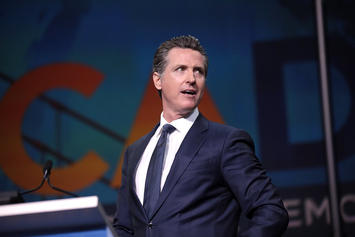
Left to its own devices, California’s Republican Party would be ready to be embalmed for display at the Museum of Natural History. But there’s one last hope for the state GOP: the growing lunacy among Democrats.
Many positions now taken for granted by Democrats should threaten their hold on the bulk of California’s middle- and working-class voters.
State policies that promote the idea of essentially open borders may not be popular even among Latinos born here or naturalized. Newsom’s move to expand Medi-Cal to illegal immigrants might not appeal to Californians at a time when the leading Democratic presidential candidates propose wiping out the private insurance held by the vast majority of unretired California households. Attacking the choices of middle-class residents, who tend to vote, in favor of greater generosity to undocumented immigrants who don’t may not be the most brilliant electoral strategy.
Additionally, their flawed, draconian positions on what to do about climate change have made things worse for ordinary Californians by raising housing and energy prices as well as chasing employers out of the state, but with only mediocre results. Future moves being contemplated threaten to impose controls on how people get to work in a state where, in the vast majority of places, transit is not a convenient, or even remotely feasible, alternative.
Latent opposition
Most Californians clearly embrace some climate-change activism, oppose Trump’s harsh nativist rhetoric and policies and want more affordable housing. But the progressive agenda is not delivering much more than virtue-signaling soundbites.
After a strong economic performance earlier this decade, there’s been a growing concern about the state’s economy and future. California’s consumer confidence rankings have been tanking, down 24 percent compared to the past year, twice the rate of decline in the rest of the country. Negativity is much stronger in the inland areas and Southern California than in the tech-driven Bay Area.
Some of the favored programs of the gentry left, notably the high-speed rail project, are increasingly out of favor with most voters. Perhaps even more revealing, Gavin Newsom, among the nation’s governors, ranks a measly 45th out of 50 with 43 percent approval. Jerry Brown did only slightly better by 2018 despite his iconic status. Approval for the Democratic-dominated legislature is even lower, at 39%.
A class warfare strategy
There’s plenty of grounds for dissent — the state’s highest-in-the-nation poverty rate, gaping inequality, low rate of homeownership, notably in the big coastal metropolitan areas, some of the nation’s worst roads and grossly underperforming schools. These inequities should be the focus of the new California opposition.
Wealthy taxpayers may be shelling out ever more money, as progressives prefer, but overall the poor and working families don’t seem to be benefiting much. As for the undocumented, most, including in Los Angeles, live in poverty, despite the “protections” offered by the state. Similarly, despite massive spikes in spending, homelessness seems to be getting worse, turning large swaths of Los Angeles and San Francisco into replicas of Mumbai.
These problems may be easy to ignore for the uber-rich of Silicon Valley, Hollywood or the luxury real estate industry, but cannot be so easily sloughed off by most Californians.
Can the GOP take advantage?
As a lifelong Democrat, and current independent, I would prefer to see a new third party dedicated to sensible policy and broad-based economic growth. But in this country, third parties generally do poorly. If you want to impact policy, as socialist independent Bernie Sanders realized, you need to do it through the two major parties.
So, what would a new opposition look like?
It would need to incorporate some elements of Trumpism in terms of breaking with the gentry left, but without the nativist and incendiary tone adopted by the president and his most fervent supporters. The role models already exist in the success of other Republicans, such as the nation’s two most popular governors, Massachusetts’ Charlie Baker and Maryland’s Larry Hogan, who enjoy over 70 percent approval ratings in their indigo-blue states.
Despite overwhelming Democratic registration advantages, these politicians have succeeded by marshalling business support and by addressing fiscal issues, on which Democrats face challenges from their union allies, and by avoiding the kind of divisive rhetoric that hurts Trump, and many GOP candidates, from winning voters in blue states. Running in the center of issues like immigration, guns and abortion, they have deprived their Democratic opponents any place in the center, forcing them to move ever further to the left on all key issues.
To appeal beyond the shrinking base, you need a positive program centered on reining in pensions, reform of schools, better attention to roads, promoting new houses in redundant commercial areas as well as the periphery and cuts in the cost of energy. Focus on these issues would expose Democrats as creatures of special interest — teachers unions, public employee groups, the renewable energy lobbies — whose power hurts middle-class homeowners, a group vote far more likely than renters to vote but which has been drifting away from them for a generation.
Some ideologues may call this kind of appeal pandering; I call it politics. People are not going to elect Adam Smith to replace empty suits like Newsom or the fervent ideologues elected to legislative office. There cannot be change until Republicans, or a new party, offer candidates who can present a coherent program for a better, more economically inclusive California.
This piece originally appeared in The Orange County Register.
Joel Kotkin is executive editor of NewGeography.com. He is the Roger Hobbs Distinguished Fellow in Urban Studies at Chapman University and executive director of the Houston-based Center for Opportunity Urbanism. His newest book is The Human City: Urbanism for the rest of us. He is also author of The New Class Conflict, The City: A Global History, and The Next Hundred Million: America in 2050. He lives in Orange County, CA.
Photo credit: Gage Skidmore, via Flickr, using CC License.












